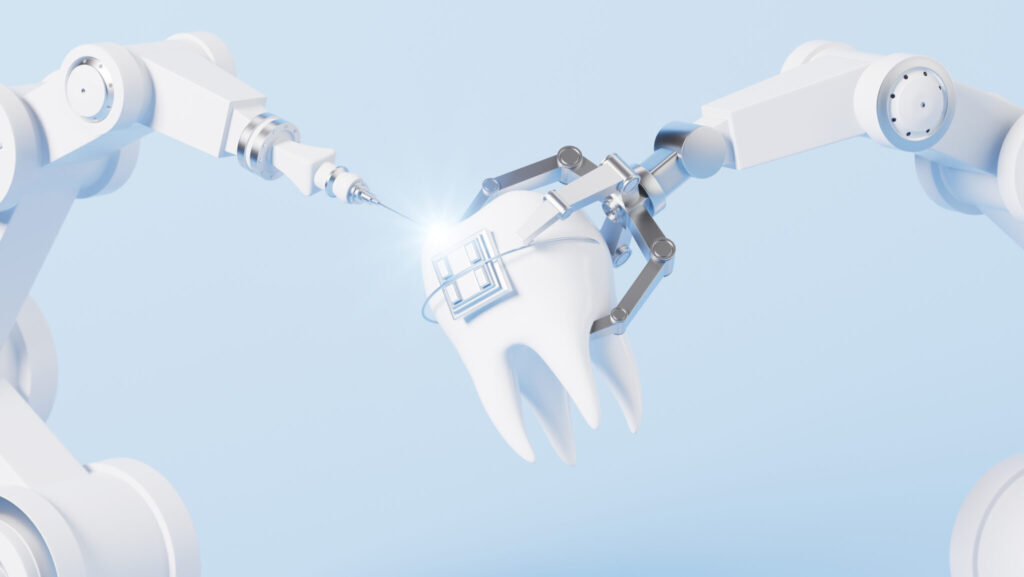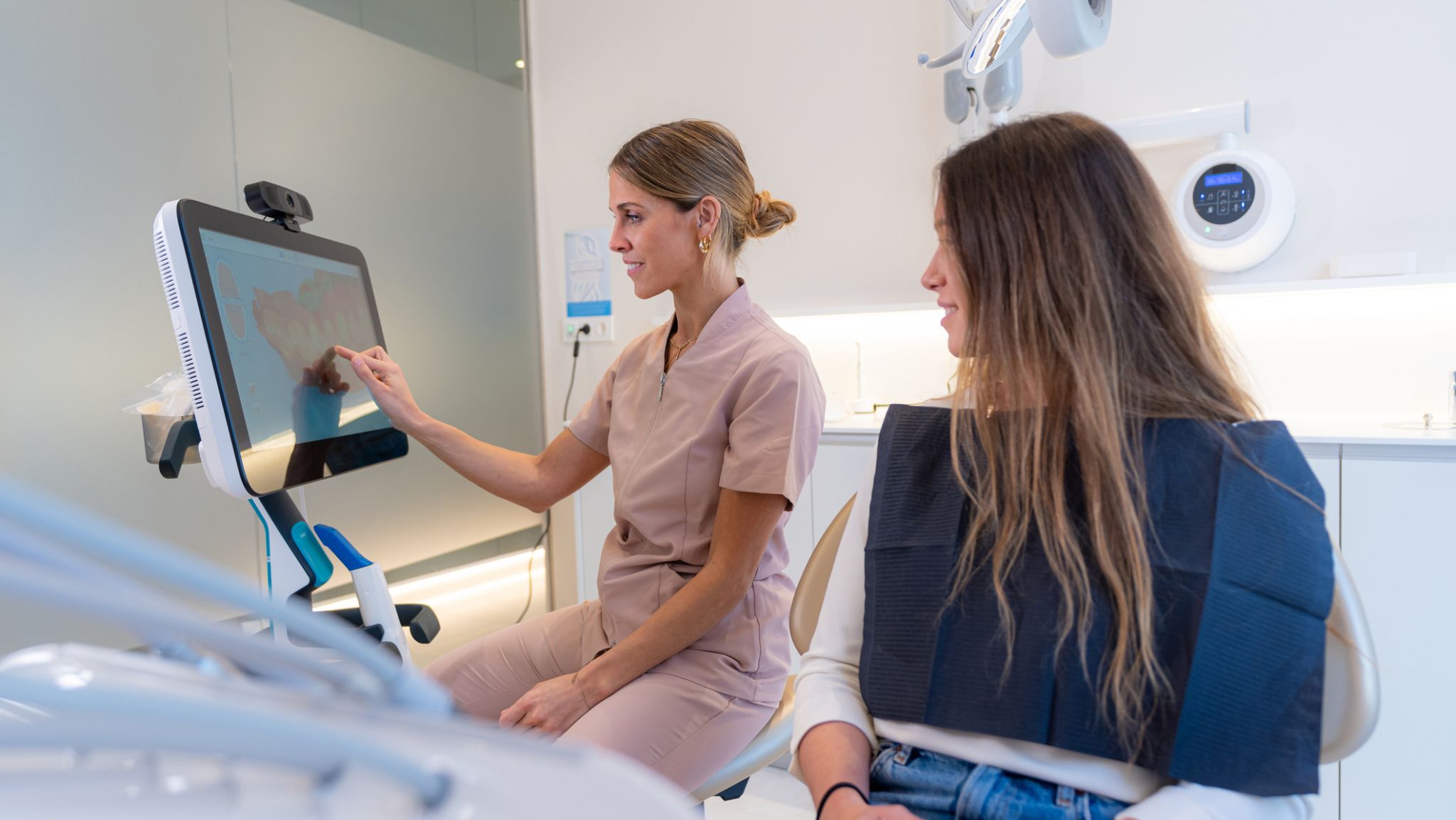
Introduction to artificial intelligence in dentistry
Today, the role of artificial intelligence has become stronger within the field of medicine and dentistry. It is getting difficult to keep up with this change. Many tasks performed by humans for many years are now done by machines with the help of artificial intelligence. The main goal of this transition is to make diagnostics, therapy, and treatment easier, cheaper, and more reliable. Dentistry has revolutionized in terms of practice and treatment with technological development. From digital imaging systems to robotic surgeries, devices offer a wide range of uses in the field of dentistry. Research on artificial intelligence in medicine has shown evidence of its integration in the field. Image recognition-based tasks in dentistry are a part of artificial intelligence. Additionally, deep learning networks, an updated topic of artificial intelligence, can be applied in dentistry to solve predetermined problems automatically by learning from generated data.
Despite the technological advances in the dental field revolutionizing practice, integrating artificial intelligence (AI) in providing dental services is yet to be imminently realized. Still under research and development, AI tools have showcased significant potential in the evaluation and prognostication of dental lesions, especially caries and endodontic conditions. Effective integration of AI tools in dental service provision depends on different agents, including technology providers, demanders of dental services, and the dental workforce. Integrating AI in dentistry should facilitate effective, reliable, efficient, and prompt delivery of dental services. To avoid the limitations that characterized AI application in general health, which widened the digital health divide, it is important to consider these aspects in the conceptualization, design, and utilization of AI systems that target dental care delivery. The main hope of AI lies in effective complementarity with the human workforce in the dental field rather than substitution, especially in light of increasing concerns over the cybersecurity of AI-supported health service provision.
Historical development and evolution of AI in dentistry
Historically, efforts to adopt AI in healthcare have evolved through four phases. The first phase realized the creation of expert-based systems. Next, scientific knowledge in medicine got codified into databases, leading to empirical systems for medicine. Following this was the large-scale connectionist model—artificial neural networks—eventually leading to recent naturalized systems. These evolutionary changes were accompanied by advances in knowledge systems like unified medical language, speech- to-text and voice recognition, and large-scale enterprise-based medical records.
The apogee of these healthcare-related AI advances came with the wins that expert systems scored in backgammon and game shows over their competitors. Even when there are ethical, managerial, and security challenges to be addressed, AI has generated optimism concerning the use of data systems, deep learning, algorithmic systems, natural language processing, computer vision, and data speech in precision medicine, mental care, healthcare logistics, and diagnostics. The rise of AI has seen an increase in the formation of partnerships and coalition deliberations at local and international levels.
Read related article: The history of artificial intelligence: From ancient times to modern times
Applications of AI in dental imaging and diagnosis
Effective delivery techniques
Radiographic imaging techniques, such as panoramic radiography, intraoral radiography, dental cone-beam computed tomography, and computed tomography, are widely used in dentistry for diagnosis, evaluation of dental anomalies, surgical planning, and pre-operative evaluation. The image quality of these dental imaging techniques affects the accuracy of diagnosis and prognostication of treatment outcomes. Improvements in dental imaging techniques and encouragement of radiographic techniques that reduce radiation exposure are integral to dentistry.
AI can produce advanced dental imaging techniques that enhance diagnosis and prognostication of treatment outcomes. In modern dentistry, we can measure the distance between two points on a dental image, distinguish dental pulp from dentin, identify the area invaded by dental caries, differentiate anatomic landmarks in a patient’s oral cavity, and assess anatomical measurements with a software application of an AI-DL algorithm to radiographic images. In addition to dental and periodontal diagnosis and treatment, AI algorithms that analyze dental and facial morphology show potential applications in orthodontics and maxillofacial surgery. With the development of AI, dental diseases have broadened from simple radiographic diagnosis to patient-specific CBCT image-based 3D navigation. AI-powered 3D navigation for surgery planning of the jawbone proposes advanced digital dentistry. AI-powered dental imaging and diagnosis applications contribute to cost savings in treatments and reduction of dentally relevant radiation dosage. Noteworthily, beyond the advantages of efficiency and reduced cost, medical applications of AI-powered 3D navigation contribute to overall patient safety in planned CBCT imaging. Dental implant placement is one of the most profitable treatments for which AI-powered three-dimensional image navigation has been applied in oral surgery. In summary, AI-powered daily clinical dental imaging and diagnosis may accelerate treatment outcomes for dentists and patient benefits.
Automated image analysis
There have been several approaches used in the regulation of dental image analysis, with the need for increased automation resulting from the increased amounts of data that are being obtained during studies. Whereas previously, time- consuming manual correction was considered common practice, the possibility of automatic correction opens the doors for completely unsupervised image processing. A method using confidence parameters employed a density distribution of reversing voxels using a dataset from two digital dental image receptors. An active contour method was incorporated with earlier methods to handle teeth with poor edge quality. The Hough transform seems to be a popular method for section grouping in the detection of teeth and creating topography maps in CT image data.
Artificial intelligence also plays a significant role in solving certain challenges in dental specialties by offering innovative solutions. An end-to-end AI feature learning-based framework possesses several advantages: it directly uses raw 2D surface and 3D voxel data for feature learning, requires no manual feature engineering, and offers the possibility for automatic image correction in the pipeline. This automatic and adaptive deep learning-based 3D dental image retrieval system automatically rectifies images based on content-aware features to ensure the correct occlusal plane and dental side to derive the feature for image- based image retrieval. It facilitates fast and easy localization of dental-specific structures in the database and offers the ability to maximize patient diagnosis while minimizing radiation exposure during dental diagnosis.
Computer-aided diagnosis
Computer-aided diagnosis is a diagnostic strategy in which an AI algorithm helps support decision-making tasks involving pathologists. The most known and applied example of CAD in dentistry is the identification of dental caries. This type of assistance is essential since an average radiograph of a patient’s skull is very rich in visual information, making manual analysis laborious, slow, and error prone. Moreover, such analysis would have to be performed by highly skilled and experienced radiologists, leading to high costs and slow disease progression analysis. Instead, several studies have shown that AI algorithms can assist dentists by predicting where caries are located, how deep into dentin the caries have advanced, and how the density, i.e., the shade of the image, varies in the carious area. The performance, sensitivity, and specificity of these systems are high, many times surpassing the average human expert.
Another important example of the application of CAD in dentistry is the detection of periodontitis. Dental radiographs are also the most frequently used outputs of this advanced system. A typical periodontitis detection algorithm first locates the boundary of the precise level of the alveolar crest for every tooth, then estimates the angle of the bone resorption, and finally segments accurately the defect. Another symptom that can be identified from dental radiographs is periapical lesions, for example, in the case of an apicoectomy, which is an invasive treatment that unnecessarily decreases the chance of the retention of the dental element.
3D imaging and virtual reality
3D imaging and virtual reality will change how dentists diagnose, plan, and execute dental procedures. The 3D imaging allows accurate representations of extraoral and intraoral structures, sizes, and shapes. It allows dentists to plan the surgical procedures, including implant placement and accurate bone dimension measurements in a virtual environment. The use of the virtual reality system will allow dentists to gain information from the 3D image and integrate augmented reality with holographic images of their patient pathology or anatomical landmarks. The additional advancement of this technology will allow them to assess the movement of the patient’s jaw in real-time integrated with 3D measurement data, which may offer an affordable VR-based solution. This technology cannot only be used by dentists, as is the current trend, where practitioners including oral and maxillofacial surgeons are using VR-based haptic simulation to practice dental surgery; consumers could also utilize the continuous advancement of head-mounted displays. In other words, through this technology, patients could view their virtual tooth and select their tooth shape and shade, eliminating the inexact color selection of traditional dental impressions and 2D photo imaging. Beyond the current application where this technology is used by doctors and patients, dental educators and students could use this technology to provide interactive and immersive learning experiences, transforming the study of the tooth into a study accessing 3D, alongside which the student can walk. These developments in AI will allow smarter imaging systems, offering assistance to the dentistry team while also creating the ideal devices or products that meet a variety of data acquisition needs. Three-dimensional and 4D imaging will evolve and offer dentists a canonical source of specialized data for the treatment of oral diseases.
AI-driven treatment planning and precision dentistry
This study briefly reviewed the potential key roles of AI in oral healthcare and related dental fields. The summary insights generated included (a) the potential transformational role during professional training, practice, and beyond, (b) the intricate engagement of AI technology in multimodality data mining and interpretation, and (c) ethical and societal issues, legal and policy matters, and data stewardship concerns that implore systematic attention. With the occasion of this review, an enhanced consensus for the field of AI applications in dentistry and beyond for a broad and positive public benefit was encouraged.
In an era where big multiscale data size and complexity reign, the potential for a more comprehensive AI-machine learning treatment planning approach for the sake of precision dentistry becomes realistic. Understandably, the AI-driven machine learning approach only sets the perimeter for eventual refinement by a dental professional. However, AI advances unquestionably employ the potential for the metamorphosis of oral health research, the subspecialties therein, and clinical practice. The height of public, patient, and professional expectations for this promising field commands that AI advances be systematically matched to societal and professional trust. Educational institutions, professional organizations, and government develop accordingly to meet these current and future demands.
Teledentistry and remote monitoring
With an increasing demand for dental services and an increased shortage of dental professionals, teledentistry concepts are becoming more popular. It allows for both remote clinical and non-clinical services. These include synchronous and asynchronous confidential and secure clinical information communication technologies between a dental professional and a patient or between dental professionals and among providers. Remote clinical assessment performed through teleconsultation can help in providing necessary care to persons who cannot access it due to distance, isolation, or an existing health condition. The progress made in digital oral imaging and data storage, transmission of digital radiographs, intraoral photographs, and videoconferencing has especially enabled this transition. Teledental diagnostic and treatment advice services have the potential to improve healthcare access and outcomes. These services, whether diagnostic or treatment-based, are classified based on different imaging applications, such as digital imaging, electronic filing of diagnostic information, and the acquisition, storage, and transmission of diagnostic images. With higher levels of diagnostic accuracy, remote communication, and interprofessional referral links, it is becoming an important aspect of mobile health. The success of these new digital tools has a marked influence on their utilization, the corresponding legislation, reimbursement, and patient and provider collaboration, especially compliance with ethical principles and professional standards.
Challenges and ethical considerations in AI integration
As dentists and clinicians, we have a duty to be well-informed about the treatment options available in order to inform, educate, and help our patients make optimal choices. As with most emerging technologies, the integration of AI does not come without its challenges. Failure to ponder potential hazards resulting from the implementation and development of AI systems could lead to a compromise of patient safety where AI systems are integrated to a certain level and allowed to perform at a level that the underlying learning framework will not be able to support. This discussion shall continue with some of the challenges and ethical guidelines that practitioners, regulatory bodies, and those involved in its implementation should consider. Researchers using selective parts of large datasets instead of the entire set are subject to selection bias and risk developing predictive algorithms that do not necessarily represent the entire target population, leading to overfitting: a form of algorithmic bias that may limit the generalizability of the model in the real world. Additionally, biases possessed by clinical experts at the input level may be inadvertently injected into the learning algorithm, thus carrying them through to predictions. Possible solutions to such shortcomings include transparent AI methods. Transparent algorithms open the black box and provide reasons for predictions such as feature visualization or prediction. Sufficient explanations regarding which factors an AI model used to predict a particular outcome can guide the decision to agree or disagree with the ML algorithm’s output. Transparent algorithms for practitioners are a stepping stone to gaining trust in AI.
Future directions and emerging technologies in AI and dentistry
As AI becomes more accurate, costs decrease, and an increased number of studies are successfully implemented, its overall use should increase over time. We anticipate that with AI technology and advanced mobile dental equipment, dental professionals of the future will provide remote diagnostics and systematic information collection, which will aid oral health care in underserved populations. Informatics generated by AI are expected to greatly influence future trends in medicine, including dentistry. There are a few other emerging technology trends that are predicted to have a significant impact in dentistry in general, as well as in biomaterial science and biomechanics, which might be linked to the field of AI and oral informatics. For example, blockchain, a digital transaction protocol that is permissionless, secure, and transparent, will likely have future implications in digitized health care data through interconnected devices and sensors for secure information exchange and to maintain interoperability of unique patient identifiers. Overall, the rapid technological advances in imaging, computing, telecommunication, intelligent systems, and artificial intelligence fields will likely be highly beneficial for the safety and care of future patients. The application of these advanced technologies in dental research and practice would accelerate together with the world’s increasing population, the greying demographic structure, and oral health-related problems, which continually increase the oral health care needs, including the need for artificial teeth, swallowing, speech, and chewing abilities. Researchers are encouraged to embrace these groundbreaking technologies to maximize the efficiency and effectiveness of dental services. Moreover, advances in dental informatics, materials informatics, and oral health-related systems that are enabled by intelligent engineering techniques can contribute to human happiness and the achievement of the Sustainable Development Goals.
The integration of artificial intelligence (AI) into dental practices, particularly in the context of 3D scanning technologies, has garnered significant attention in recent years. This literature review aims to synthesize the evolving landscape of AI applications in dentistry, focusing on its implications for 3D imaging and intraoral scanning.
In their 2020 study, Hung et al.1 conducted a comprehensive literature search to identify existing applications of AI in 3D imaging within dentistry. Their analysis revealed that while there is a burgeoning interest in this field, methodological concerns persist, particularly regarding the risk of bias in studies. The authors highlighted three primary applications of AI: automated diagnosis of dental and maxillofacial diseases, localization of anatomical landmarks for orthodontic treatment, and enhancement of image quality. Despite the promising advancements, the authors noted that many studies did not validate their AI models on independent datasets, which raises questions about the reliability of the findings.1
Building on this foundation, Ahmed et al.2 provided a systematic review that emphasized the transformative potential of AI in clinical diagnosis and treatment planning within dentistry. Their findings indicated that AI technologies, particularly those employing deep learning and convolutional neural networks, demonstrated high accuracy in various applications, including the detection of malocclusion, classification of dental restorations, and identification of periodontal diseases. This study underscored the ability of AI to enhance precision in routine dental procedures and the integration of facial and intraoral images for comprehensive patient analysis. However, the authors also cautioned that the full potential of AI in dental diagnostics and management remains to be fully realized.2
Most recently, Altalhi et al.3 explored the role of AI specifically in dental implantology, emphasizing its dual-phase operation involving training and testing. The authors reviewed the literature to assess how AI contributes to treatment planning, particularly with cone beam computed tomography (CBCT) scans, which are considered the gold standard in this area. They pointed out that while AI applications in implant dentistry have shown promise, particularly in planning procedures, challenges remain regarding the effectiveness of these technologies in real-world scenarios. The review highlighted the need for further research to validate the utility of AI in enhancing the success and survival rates of dental implants.3
Through this analysis, it becomes evident that while AI presents substantial opportunities for improving the accuracy and efficiency of dental practices, particularly in 3D imaging and scanning, there are critical limitations and methodological concerns that must be addressed to fully harness its potential.
References
- Hung, K., Wai Kan Yeung, A., Tanaka, R., & M. Bornstein, M., 2020. Current Applications, Opportunities, and Limitations of AI for 3D Imaging in Dental Research and Practice. ncbi.nlm.nih.gov
- Ahmed, N., Shakoor Abbasi, M., Zuberi, F., Qamar, W., Syahrizal Bin Halim, M., Maqsood, A., & Khursheed Alam, M., 2021. Artificial Intelligence Techniques: Analysis, Application, and Outcome in Dentistry—A Systematic Review. ncbi.nlm.nih.gov
- M Altalhi, A., S Alharbi, F., A Alhodaithy, M., S Almarshedy, B., Y Al-saaib, M., M Al jfshar, R., S Aljohani, A., H Alshareef, A., Muhayya, M., & H AL-harbi, N., 2023. The Impact of Artificial Intelligence on Dental Implantology: A Narrative Review. ncbi.nlm.nih.gov
About the author

Prof. MUDr. Alaa Abu Shareia, MSc, DSc, Banska Bystrica, Slovakia, 2024.











